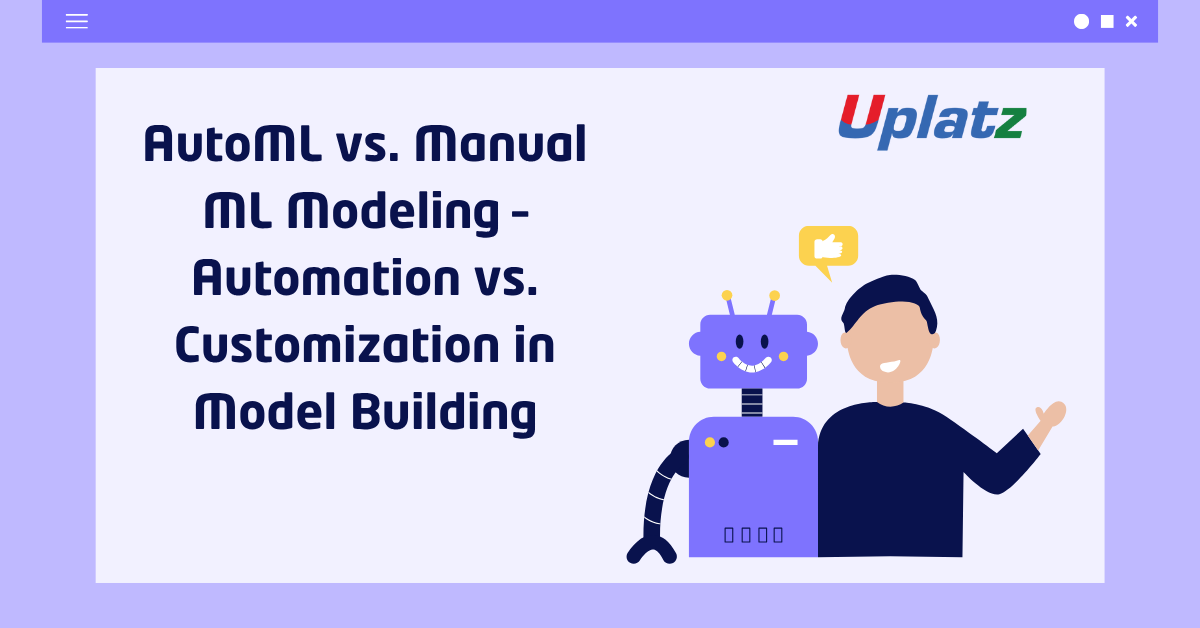AutoML vs. Manual ML Modeling – Automation vs. Customization in Model Building
Modern machine learning projects hinge on the balance between speed and accessibility provided by Automated Machine Learning (AutoML) and the fine-grained control and customization enabled by manual modeling. This report compares these two approaches across key dimensions—workflow, expertise, customization, performance, interpretability, and cost—to guide practitioners in selecting the right strategy for their needs.

- Workflow and Process
AutoML Workflow
AutoML platforms orchestrate the entire modeling pipeline—from data preprocessing and feature engineering to model selection, hyperparameter tuning, and evaluation—through automation engines and search algorithms. Users typically supply raw datasets and problem definitions; the system then iteratively explores transformations, algorithms, and hyperparameters using methods such as Bayesian optimization or evolutionary algorithms
Manual ML Workflow
In manual modeling, data scientists design each pipeline component by hand: data cleaning, domain-driven feature engineering, algorithm selection, hyperparameter tuning (e.g., grid or random search), and performance evaluation. This process relies on human expertise to craft tailored solutions, with iterative cycles of experimentation and adjustment
- Required Expertise
- AutoML: Lowers the barrier to entry by abstracting complex tasks. Users with limited ML background can generate baseline models quickly, while experts can accelerate prototyping
- Manual ML: Demands deep knowledge of algorithms, statistics, and domain context. Practitioners must understand model behavior, feature interactions, and tuning techniques to optimize performance
- Customization and Control
| Aspect | AutoML | Manual ML |
| Feature Engineering | Automated, generic transformations | Domain-specific, handcrafted features |
| Algorithm Selection | Predefined search space | Any algorithm, including cutting-edge research models |
| Hyperparameter Tuning | Black-box optimization | Full transparency and manual fine-tuning |
| Pipeline Adjustments | Limited by platform capabilities | Unlimited flexibility |
AutoML restricts customization to presets supported by the platform, potentially missing niche optimizations. Manual ML affords full control to implement novel algorithms, custom loss functions, or specialized data augmentations
Performance and Accuracy
- AutoML: Often achieves competitive accuracy by exhaustively searching standard pipelines, especially on common tabular tasks. However, expert-crafted models can outperform AutoML in specialized domains where domain knowledge guides feature design and algorithm choice
- Manual ML: Skilled practitioners can extract higher performance margins by leveraging custom features, ensembling strategies, and model architectures tuned for data idiosyncrasies
- Interpretability and Transparency
- AutoML: Produces black-box models that are difficult to interpret or debug. The automated pipeline’s decision logic often lacks clear documentation of why specific transformations or hyperparameters were chosen
- Manual ML: Enables transparent modeling; every feature and parameter decision is explicable, facilitating model validation, compliance, and trust in regulated industries[7].
- Resource Consumption and Cost
- AutoML: Requires substantial computational resources for exhaustive searches and ensembling, which can drive up cloud compute costs, especially for large datasets[6]. Licensing fees for enterprise AutoML platforms may add to expenses.
- Manual ML: While manual tuning is labor-intensive, compute usage can be more targeted. Experts can design efficient experiments and reuse artifacts, potentially reducing overall resource consumption
- Use Cases and Decision Guidelines
Choose AutoML When:
- Rapid prototyping or proof-of-concept is needed.
- Team lacks deep ML expertise but requires workable models.
- Time-to-market and resource constraints outweigh marginal accuracy gains.
Choose Manual ML When:
- Problem domain demands specialized feature engineering or novel algorithms.
- Maximum performance and interpretability are critical (e.g., healthcare, finance).
- Regulatory requirements mandate model explainability and audit trails.
- Hybrid Approaches
Many organizations adopt a hybrid strategy, leveraging AutoML for initial model generation and then refining top candidates through manual feature enhancements, ensembling, or custom architectures. This combines speed and expert-driven optimization to achieve robust solutions.
Balancing automation with customization is essential for effective model building. AutoML accelerates development for general tasks, while manual modeling unlocks deeper performance and transparency for domain-specific challenges. Selecting the right approach—or integrating both—depends on project requirements, expertise, and resource considerations.
